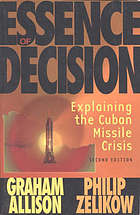Session 23
ORGANIZATIONAL CULTURE; PROs AND CONs
ORGANIZATIONAL CULTURE PLAYED KEY ROLES IN TWO EVENTS OF THE 20TH CENTURY
21 years later, this happened.
Today, Octet will lead us in a consideration of 1962
1962
"... we are assuming governmental behavior can be most satisfactorily understood by analogy with the purposive acts of individuals ... it obscures the persistently neglected factor of bureaucracy; the 'maker' of government policy is not one calculating decisionmaker but is rather a conglomerate of large organizations and political actors ..."
THE SECOND OF TWO CLASSIC STUDIES OF THE ROLE OF ORGANIZATIONAL CULTURE IN DECISION MAKING
Leaders in Crisis: President John F. Kennedy - Cuban Missile Crisis, 1962
Read part of Graham Allison's take on 1962
Allison, G. T. (1971).
Essence of decision: Explaining the Cuban missile crisis.
Boston: Little, Brown
read pages v-viii;
skim pages 10-38, 87-100, 144-184;
read pages 245-263; and
skim pages 264-277
For explaining and predicting the behavior of individual men, this general orientation toward purpose and rational choice seems to be the best available. The rationality of man's choices is, of course, "bounded" by things such as the availability of information and the difficulty of calculation. But as a baseline, if one knows how an individual has defined his problem and what resources he has available, his objectives provide a good clue to his behavior.top
Difficulties arise when the thing to be explained is not the behavior of an individual but rather the behavior of a large organization or even a government.
compare how the decisions in this situation were affected by organizational culture
You read Saving 'Boxer 22'. Here compare the story there to The Rescue of Roger Locher.
Is there anything to learn about how organizational memories are born and transmitted? Do you think the first story affected the second?
topTHINGS WE'LL TALK ABOUT
- using Allison's examples, we'll reflect on the benefits and disadvantages of organizational culture
- why is an organizational culture necessary?
- does it help organizations orient their goals and prioritize?
- does it make organizations vulnerable to stagnation?
- think of companies and organizations that refused to change their organizational culture and suffered as a result
SOMETHING TO TAKE AWAY
Robert Hood & Femi Kuti jouent James Brown
In France TV's Variations showcases, duos create electronic-acoustic collaborations that are like dives into the unknown. In its fourth season in 2019, Variations presented an unprecedented encounter of Detroit techno innovator Robert Hood with Afrobeat saxophonist Femi Kuti to bring to new life to the little-known music of the Godfather of Soul, James Brown. The jazz side of JB from the horn of Pee Wee Ellis was the focus. The electronic producer largely lays the foundation for the set with his minimalist beats and experimental colors which free Kuti to deliver his explosive improvisations. Kuti says that Robert “built the house and I did the decoration.” There are stretches of call-and-response grooves as well as chants of “stomp your feet” and sample-like JB singular shouts. Femi's father was the master Fela Kuti who controversially jazzified the Ghana-born highlife music in his native Nigeria and became known as the African James Brown. He was the chief purveyor of Afrobeat. A virtuoso on his instrument, Femi takes the source and charges ahead with an edgy brew of pop, soul, avant-jazz. No lyricism, just grit and determination. While the pair had never worked together, based on a telephone conversation prior to this show, they agreed that they linked spiritually.
Dan Ouellette
Last Updated on | Copyright © R.E. Bergquist 2014- | Powered by w3.css